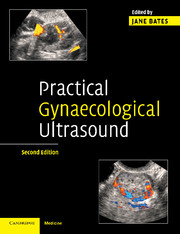Book contents
- Frontmatter
- Contents
- List of contributors
- Preface
- 1 Equipment selection and instrumentation
- 2 Practical equipment operation and technique
- 3 Anatomy, physiology and ultrasound appearances
- 4 Pathology of the uterus, cervix and vagina
- 5 Pathology of the ovaries, fallopian tubes and adnexae
- 6 Ultrasound in the acute pelvis
- 7 Ultrasound and fertility
- 8 Paediatric gynaecological ultrasound
- 9 Clinical management of patients: the gynaecologist's perspective
- Index
- References
7 - Ultrasound and fertility
Published online by Cambridge University Press: 04 March 2010
- Frontmatter
- Contents
- List of contributors
- Preface
- 1 Equipment selection and instrumentation
- 2 Practical equipment operation and technique
- 3 Anatomy, physiology and ultrasound appearances
- 4 Pathology of the uterus, cervix and vagina
- 5 Pathology of the ovaries, fallopian tubes and adnexae
- 6 Ultrasound in the acute pelvis
- 7 Ultrasound and fertility
- 8 Paediatric gynaecological ultrasound
- 9 Clinical management of patients: the gynaecologist's perspective
- Index
- References
Summary
Introduction
Ultrasound is the single most useful agent in evaluating human fertility. Not only do the fluid–tissue interfaces in the female pelvic organs allow precise measurements of structure but the low cost and safety of ultrasound scanning allow repeated examinations and hence, most importantly, an understanding of function (Table 7.1).
Although transabdominal ultrasound is used occasionally, for example when surgery has moved ovaries from their normal location, the vast majority of scans are performed vaginally. The close proximity of the ovaries and uterus to the vaginal fornices allows for the use of higher frequencies (∼10 MHz) and hence higher resolution.
Subfertility is common. Some 19% of pregnancies take more than a year to conceive and one in six of all couples are referred for fertility investigations at some time during their lives.
Ovarian function
A human ovary contains many thousands of germ cells distributed throughout its stroma, each of which is surrounded by a small number of specialist cells to create a primordial follicle. These follicle complexes begin to develop one by one throughout reproductive life in response to gonadotrophin hormones secreted by the pituitary gland but they only become visible to ultrasound in their later stages of development when they develop a fluid-filled antrum. These fluid-filled follicles give the ovary its characteristic appearance during the reproductive years. When visualising the ovary it is important to remember that its structure is constantly changing as part of a dynamic system involving many other organs.
- Type
- Chapter
- Information
- Practical Gynaecological Ultrasound , pp. 120 - 125Publisher: Cambridge University PressPrint publication year: 2006



